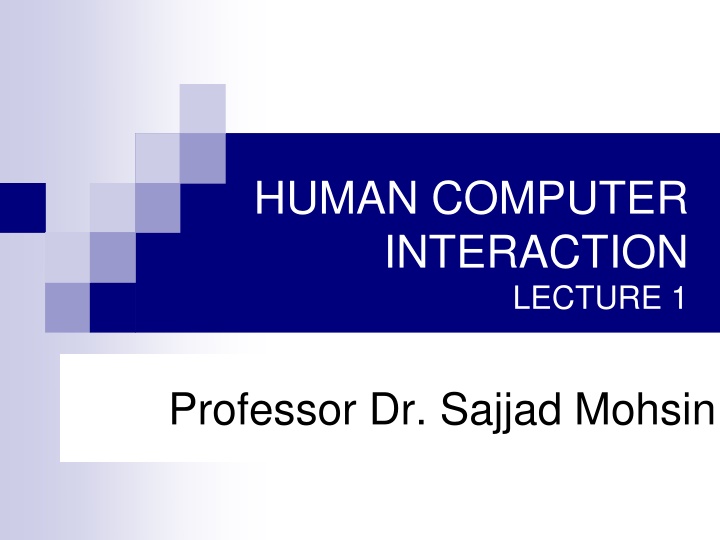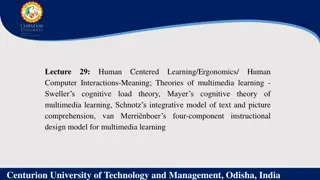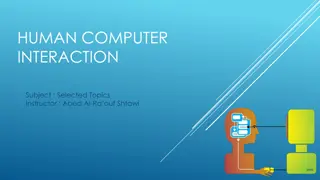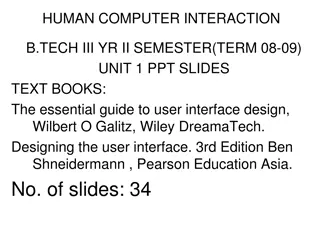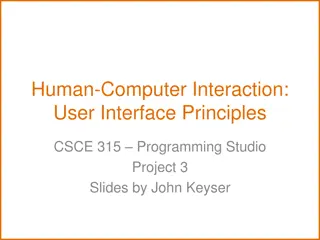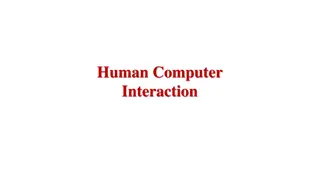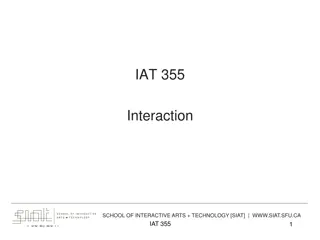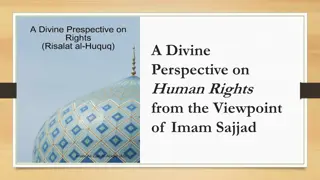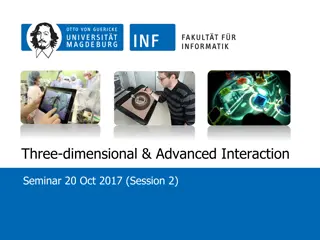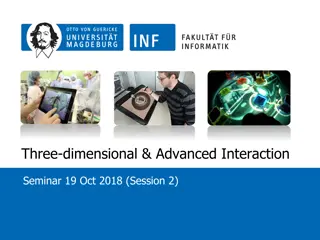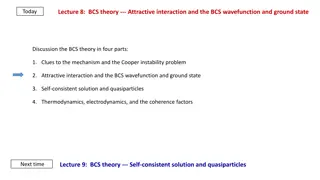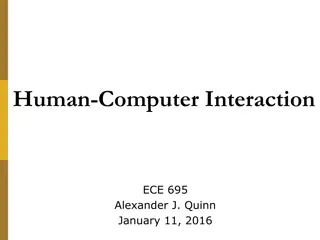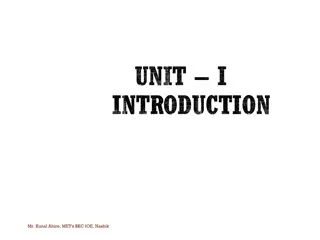Human-Computer Interaction Lecture with Professor Dr. Sajjad Mohsin
Professor Dr. Sajjad Mohsin is an experienced academician and researcher with a diverse background in computer science and information technology. He has held various key positions at reputable institutions in Pakistan and Japan, contributing significantly to research projects in telecommunication networks, image processing, and mental health care. His expertise in human-computer interaction is evident from his leadership roles and funded research projects. With a strong academic foundation and practical experience, Professor Mohsin continues to make valuable contributions to the field of computer science.
Download Presentation

Please find below an Image/Link to download the presentation.
The content on the website is provided AS IS for your information and personal use only. It may not be sold, licensed, or shared on other websites without obtaining consent from the author.If you encounter any issues during the download, it is possible that the publisher has removed the file from their server.
You are allowed to download the files provided on this website for personal or commercial use, subject to the condition that they are used lawfully. All files are the property of their respective owners.
The content on the website is provided AS IS for your information and personal use only. It may not be sold, licensed, or shared on other websites without obtaining consent from the author.
E N D
Presentation Transcript
HUMAN COMPUTER INTERACTION LECTURE 1 Professor Dr. Sajjad Mohsin
Faculty Profile Ph.D. Division of Production, Information and Systems Engineering, Muroran Institute of Technology (MIT), Hokkaido. JAPAN M.E. Dept. of Computer Science and Systems Engineering, MIT.JAPAN M.Sc. Computer Science Department of Computer Science, Quaid-i- Azam University Islamabad, Pakistan 1A-2
Experience Professor & Dean FIST, COMSATS Institute of Information Technology Islamabad Pakistan, April 2011 to date Dean Professor)COMSATS Institute of Information Technology Islamabad Pakistan, Nov 2010 to August 2011 FIST & Chairman CS (Associate Chairman Department of Computer Science, COMSATS Institute of Information Technology Islamabad Pakistan, July 2009 to Nov 2010. & Head (Associate Professor) 1A-3
Experience Head Computer Information January 2008 to July 2009 (Associate Science, Technology Professor), COMSATS Department Institute of of Islamabad Pakistan, Associate Information Pakistan, April 2005-January 2008 Professor, Technology COMSATS Abbottabad Institute Campus, of Research Assistant with Prof. Yukinori Suzuki, MIT Japan, 2004 to 2005 Research Project: A study on Telecommunication Network Modeling. 1A-4
Experience Research Assistant with Prof. Yukinori Suzuki, MIT Japan. Research, 2003-2004 Project: A study on Congestion Control of Telecommunication Network. Teaching Assistant with Dr. Yasushi Honda, MIT Japan. Oct 2002, to Feb 2003 Subject: Information Engineering Basic Practice B. Researcher with Prof. Yukinori Suzuki at the MIT Japan, Oct 1998 to March 2000. 1A-5
Experience Systems Analyst, Central Telecom Research Laboratories (CTRL),PakistanTelecommunication Corporation Ltd. (PTCL), Islamabad. Pakistan, July 1992 Sep. 2003 Systems Analyst,National Institute of Electronics (NIE), Islamabad. Pakistan, Jun. 1987 Jul. 1992
Grants 2007 Present Higher Education Commission, Pakistan approved & funded research project "High Performance Image Processing using Genetic Algorithms on Auto-Load Balancing Symmetric Multi-Processing Platform" worth more than (Pakistan Rs.) 0.6 million 2011 2013 National ICT R&D Fund approved and funded the research project titled 3D Graphical Imagery Therapy for Healing Brain Tumors in Children worth more than 11 million PKR. 2012 2016 Grand Challenges Canada approve the project titled Improving mental health care for young adults in Badakhshan Province of Afghanistan using eHealth worth Canadian $1 Million as Co- PI in collaboration with University of Calgary, Canada. 1A-7
HONORS Distinguish Professor of IT Member Editorial Board of the IEEE Transaction of The Fuzzy Systems Journal Member Editorial Board of the World Information Technology Journal Member Editorial Board of the Information Technology Journal Approved PhD Supervisor Education Commission for Pakistan Member Australian Computer Society of Higher 1A-8
Honors Awarded Japanese Government, Ministry of Education Scholarship for Ph.D. April 2002- March 2005 Awarded Japanese Government, Ministry of Education Scholarship for M.E. April 2000 March 2002 Awarded Japanese Government, Ministry of Education Scholarship as Research Student. Oct 1998- March 2000. Awarded Merit Scholarship by the Quaid-i- Azam University Islamabad for M.Sc. Jan. 1985 Dec. 1986 1A-9
Course Learning Outcomes Upon completion of the course, students will be able to: Explain human factors of HCI including human body physical abilities, ergonomics, accessibility, health issues, cognitive load and psychology. Explain hardware factors of HCI including different input and output devices e.g. keyboard, mouse, and touchscreen. Understand different key elements from which user interfaces are constructed. Implement user-centered approach in software development process and apply suitable techniques for collecting user requirement and analyzing task. Evaluate and compare user interfaces using different techniques such as laboratory experiments and expert reviews. 10
Recommended Resources Text book Human Computer Interaction, A. Dix et al., 3rd edition, Pearson Education, Other Designing Interactive Systems: A comprehensive guide to HCI, UX and interaction design, D. Benyon, 3rd edition, Pearson Education, 2013. Designing the User Interface: Strategies for Effective Human-Computer Interaction, B. Shneiderman et al., 5th edition, Pearson Education, 2009. The essence of human computer interaction, C. Faulkner, 1st Ed. The design of everyday things, D. Norman, 2nd Ed. http://hcibib.org/ 11
Outline Introduction to HCI Alarm Clock Example Dos time versus software application Don Norman s Door Example The human Information i/o visual, auditory, haptic, movement 12
Goals of HCI Useful Accomplish what is required Play music, cook dinner, format a document Usable Do it easily and naturally Without danger of error Used Make people want to use it Be attractive, engaging, fun 13
Alarm Clock 14
DOS TIME 15
Why Study HCI Software Perspective 16
Don Normans Door Example A classic book. Read it! I will share its pdf soon Main Point: no one reads manuals, so things should be designed so that manuals are not needed BTW what is wrong with the kettle on the book cover? 18
Don Normans Door Example A plate naturally says push me and a handle naturally says pull me 19
Don Normans Door Example When Don Norman s advice is not followed 20
Vision Two stages in vision physical reception of stimulus processing and interpretation of stimulus
The Eye - physical reception mechanism for receiving light and transforming it into electrical energy light reflects from objects images are focused upside-down on retina retina contains rods for low light vision and cones for colour vision ganglion cells (brain!) detect pattern and movement
Interpreting the signal Size and depth visual angle indicates how much of view object occupies (relates to size and distance from eye) visual acuity is ability to perceive detail (limited) familiar objects perceived as constant size (in spite of changes in visual angle when far away) cues like overlapping help perception of size and depth
Interpreting the signal (cont) Brightness subjective reaction to levels of light affected by luminance of object measured by just noticeable difference visual acuity increases with luminance as does flicker Colour made up of hue, intensity, saturation cones sensitive to colour wavelengths blue acuity is lowest 8% males and 1% females colour blind
Interpreting the signal (cont) The visual system compensates for: movement changes in luminance. Context is used to resolve ambiguity Optical illusions sometimes occur due to over compensation
Optical Illusions the Ponzo illusion the Muller Lyer illusion
Reading Several stages: visual pattern perceived decoded using internal representation of language interpreted using knowledge of syntax, semantics, pragmatics Reading involves saccades and fixations Perception occurs during fixations Word shape is important to recognition Negative contrast improves reading from computer screen
Hearing Provides information about environment: distances, directions, objects etc. Physical apparatus: outer ear protects inner and amplifies sound middle ear transmits sound waves as vibrations to innerear inner ear chemical transmitters are released and cause impulses in auditory nerve Sound pitch sound frequency loudness amplitude timbre type or quality
Hearing (cont) Humans can hear frequencies from 20Hz to 15kHz less accurate distinguishing high frequencies than low. Auditory system filters sounds can attend to sounds over background noise. for example, the party phenomenon.
Touch/Haptic Provides important feedback about environment. May be key sense for someone who is visually impaired. Stimulus received via receptors in the skin: Thermo-receptors nociceptors mechanoreceptors heat and cold pain pressure (some instant, some continuous) Some areas more sensitive than others e.g. fingers. Kinesthesis - awareness of body position affects comfort and performance.
Movement Time taken to respond to stimulus: reaction time + movement time Movement time dependent on age, fitness etc. Reaction time - dependent on stimulus type: visual ~ 200ms auditory ~ 150 ms pain ~ 700ms Increasing reaction time decreases accuracy in the unskilled operator but not in the skilled operator.
Movement (cont) Fitts' Law describes the time taken to hit a screen target: Mt = a + b log2(D/S + 1) where: a and b are empirically determined constants Mt is movement time D is Distance S is Size of target targets as large as possible distances as small as possible
Fitts law Fitts law is useful for web designers when deciding where to place the next button Call to Action Buttons , links and other buttons can be strategically placed on websites/apps to increase the chance of clicking. Not only do you want to direct traffic to the right places, but users need to a have a simple and easy experience. Notice how the windows start button almost doubled in size? 33
Summary Today we learnt about, Basics of Human Computer Interaction Alarm Clock Example Dos time versus software application Don Norman s Door Example The human Information i/o visual, auditory, haptic, movement 34
